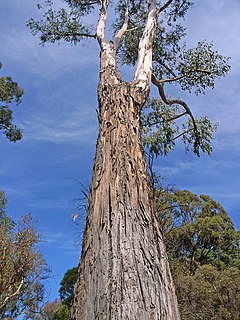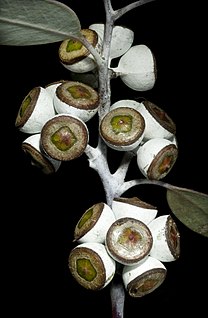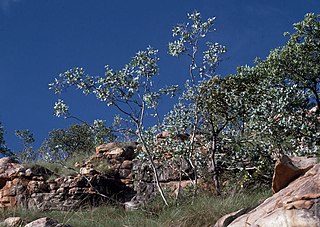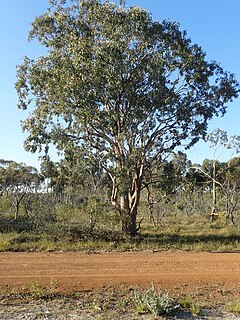
Eucalyptus wandoo, commonly known as wandoo, dooto, warrnt or wornt, is a small to medium-sized tree that is endemic to the southwest of Western Australia. It has smooth bark, lance-shaped adult leaves, flower buds in groups of nine to seventeen, white flowers and conical to cylindrical fruit. It is one of a number of similar Eucalyptus species known as wandoo.

Eucalyptus blakelyi, known as Blakely's red gum, is a tree endemic to eastern Australia. It has smooth bark on its trunk and branches, dull bluish green, lance-shaped adult leaves, flower buds usually in groups of seven, white flowers and cup-shaped to hemispherical fruit.

Eucalyptus mannifera, commonly known as the brittle gum or red spotted gum, is a species of small to medium-sized tree that is endemic to south-eastern Australia. It has smooth, powdery white bark, lance-shaped to curved adult leaves, flower buds in groups of seven, white flowers and cup-shaped, hemispherical or conical fruit.

Eucalyptus dorrigoensis, commonly known as the Dorrigo white gum, is a species of tree that is endemic to New South Wales. It has smooth white, grey or pink bark, lance-shaped to curved adult leaves, flower buds in groups of seven, white flowers and cup-shaped, conical or hemispherical fruit.

Eucalyptus bridgesiana, commonly known as apple box, apple, apple gum or but-but, is a medium to large sized tree. It has rough, fibrous bark on the trunk and larger branches, smooth grey bark above, glossy green, lance-shaped adult leaves, flower buds in groups of seven, white flowers and hemispherical fruit.

Eucalyptus dunnii, commonly known as Dunn's white gum or simply white gum, is a species of medium-sized to tall tree that is endemic to eastern Australia. It has rough bark near the base, smooth white to cream-coloured bark above, lance-shaped to curved adult leaves, flower buds in groups of seven, white flowers and cup-shaped, conical or hemispherical fruit.

Eucalyptus campaspe, commonly known as silver gimlet or the silver-topped gimlet, is a species of tree that is endemic to Western Australia. It has smooth, shiny bark, lance-shaped adult leaves, flower buds in groups of seven, white flowers and cup-shaped or conical fruit.

Eucalyptus brevifolia, commonly known as snappy white gum or northern white gum, is a tree that is endemic to northern Australia. It has smooth, powdery white bark, lance-shaped adult leaves, buds arranged in group of seven, white flowers and cup-shaped or barrel-shaped fruit.

Eucalyptus griffithsii, commonly known as Griffith's grey gum, is a species of mallee or tree that is endemic to Western Australia. It has smooth grey to whitish bark, sometimes with rough, loose fibrous bark near the base of the trunk, lance-shaped adult leaves, flower buds in groups of three, white flowers and conical to cup-shaped fruit.

Eucalyptus herbertiana, commonly known as Kalumburu gum or yellow-barked mallee, is a species of small tree or mallee that is endemic to northern Australia. It has smooth bark, lance-shaped or curved adult leaves, flower buds in groups of seven, white flowers and cup-shaped, hemispherical or conical fruit.

Eucalyptus mooreana, commonly known as Moore's gum, mountain white gum or King Leopold Range mallee, is a species of stunted, straggly tree or mallee that is endemic to the Kimberley region of Western Australia. It has smooth, powdery white bark, a crown of juvenile, sessile, stem-clasping leaves arranged in opposite pairs, flower buds arranged in groups of seven, white flowers and cup-shaped to hemispherical fruit.

Eucalyptus pantoleuca, commonly known as round-leaved gum or Panton River white gum, is a species of small tree that is endemic to the Kimberley region of Western Australia. It has smooth, powdery bark, more or less round adult leaves, flower buds in groups of three, white flowers and conical fruit that are glaucous at first.
Eucalyptus rupestris, commonly known as Prince Regent gum, is a species of small tree that is endemic to the Kimberley region of Western Australia. It has smooth bark, elliptical to egg-shaped or broadly lance-shaped adult leaves, flower buds in groups of seven, white flowers and cup-shaped to more or less cylindrical fruit.
Eucalyptus salicola, commonly known as salt gum, salt lake salmon gum or salt salmon gum, is a species of small to medium-sized tree that is endemic to the southwest of Western Australia. It has smooth, powdery bark, linear to narrow lance-shaped adult leaves, flower buds in groups of seven, nine or eleven, creamy white flowers and cup-shaped to hemispherical fruit.

Eucalyptus sheathiana, commonly known as ribbon-barked gum, is a species of tree or a mallee that is endemic to Western Australia. It has smooth bark that is shed in long ribbons, lance-shaped adult leaves, flower buds in groups of seven, creamy white flowers and conical to cup-shaped fruit.

Eucalyptus confluens, commonly known as Kimberley gum, is a species of small tree that is endemic to northern Australia. It has smooth, powdery white bark, lance-shaped adult leaves, more or less spherical flower buds in groups of seven, white flowers and cup-shaped to hemispherical fruit. It grows in the Kimberley region of Western Australia and in adjacent areas of the Northern Territory.

Eucalyptus decorticans, commonly known as the gum-top ironbark, is a species of tree that is endemic to Queensland. It has rough, dark grey or black "ironbark" on the trunk and larger branches, smooth white bark on the thinner branches, lance-shaped to curved adult leaves, flower buds in groups of seven, white flowers and conical, cup-shaped or barrel-shaped fruit.

Eucalyptus petiolaris, commonly known as Eyre Peninsula blue gum, water gum or blue gum, is a species of small to medium-sized tree that is endemic to South Australia. It is also naturalised in Western Australia. It has rough, flaky bark on the trunk, smooth greyish bark above, lance-shaped adult leaves, flower buds in groups of three, cream-coloured, yellow, pink or red flowers and cup-shaped or barrel-shaped fruit.

Eucalyptus umbrawarrensis, commonly known as the Umbrawarra gum, is a small to medium-sized tree that is endemic to the Northern Territory. It has smooth, powdery white bark, narrow lance-shaped adult leaves, flower buds in groups of seven, white flowers and cup-shaped to barrel-shaped fruit.
Eucalyptus assimilans is a tree that is endemic to Western Australia. It has smooth white or greyish bark shed in long ribbons, lance-shaped and curved leaves, buds in groups of seven in leaf axils and conical fruit.

















